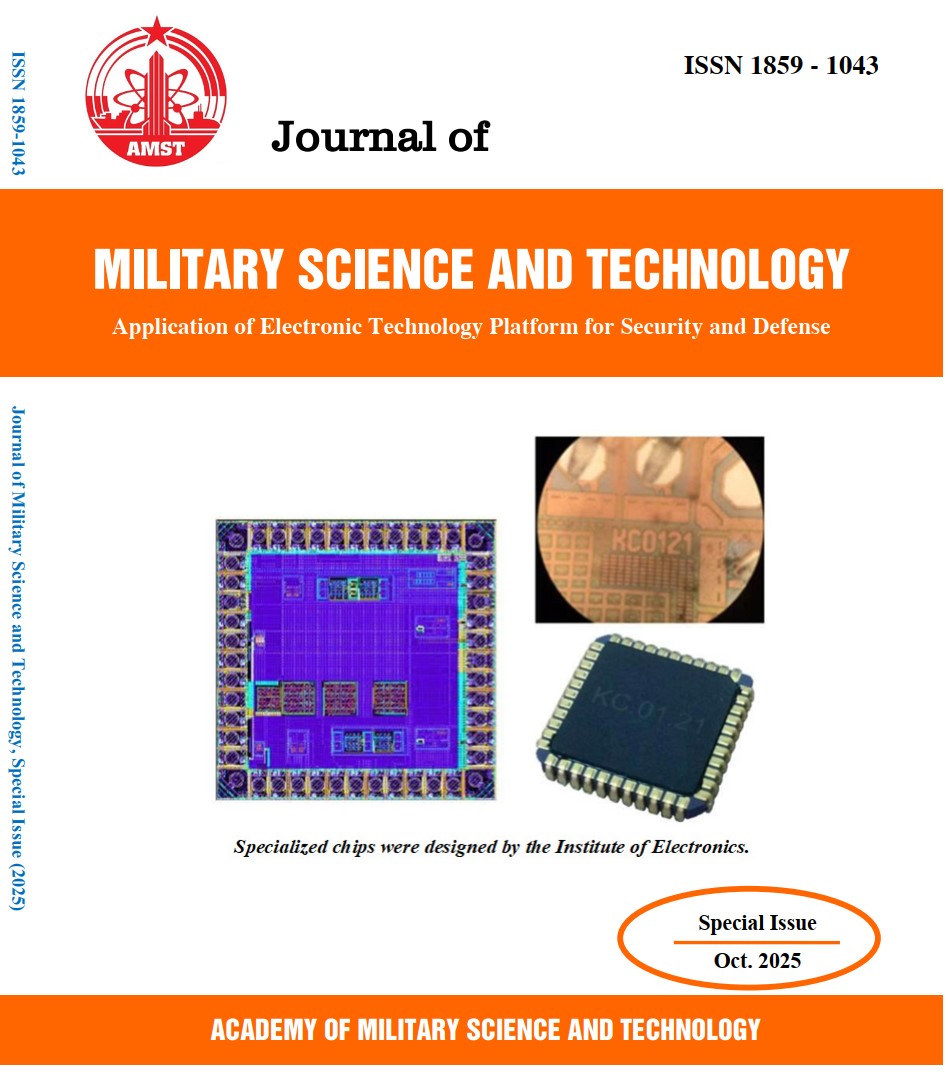Mạng hồi quy dư sâu để ước tính số lượng nguồn tín hiệu thủy âm
DOI:
https://doi.org/10.54939/1859-1043.j.mst.IITE.2025.91-98Từ khóa:
Thủy âm; Ước lượng số nguồn; Học sâu; Mạng kết nối dư.Tóm tắt
Ước tính số lượng nguồn (SNE) là một bài toán nền tảng trong xử lý tín hiệu mảng thủy âm, có vai trò quyết định đến hiệu suất của các thuật toán xử lý tiếp theo. Các phương pháp kinh điển như Tiêu chí Thông tin Akaike (AIC) và Độ dài Mô tả Tối thiểu (MDL), thường suy giảm hiệu suất nghiêm trọng trong các điều kiện bất lợi của môi trường dưới nước, đặc biệt là khi tỷ số tín hiệu trên nhiễu (SNR) thấp, số lượng mẫu (snapshots) hạn chế, và nhiễu có cấu trúc phức tạp. Để giải quyết những thách thức này, bài báo này giới thiệu một kiến trúc mạng hồi quy kết nối dư dựa trên giá trị riêng (EResNet) để ước lượng số nguồn một cách bền vững. Thông qua các mô phỏng toàn diện với nhiều kịch bản nhiễu phức tạp EResNet đã chứng tỏ hiệu quả vượt trội. Kết quả cho thấy mô hình đề xuất đạt độ chính xác cao hơn và thể hiện tính bền vững so với các thuật toán AIC, MDL cũng như các kiến trúc mạng nơ-ron cơ sở khác.
Tài liệu tham khảo
[1]. J. Barabell, “Improving the resolution performance of eigenstructure-based direction-finding algorithms,” Proc. IEEE Int. Conf. Acoust., Speech Signal Process., pp. 336–339, (1983).
[2]. F. Gao and A. B. Gershman, “A generalized ESPRIT approach to direction-of-arrival estimation”, IEEE Signal Process. Lett., Vol. 12, No. 3, pp. 254–257, (2005).
[3]. Qian, L. Huang, N. Sidiropoulos, and H. So, “Enhanced PUMA for direction-of-arrival estimation and its performance analysis,” IEEE Trans. Signal Process., Vol. 64, No. 16, pp. 4127–4137, (2016).
[4]. P. Stoica and A. Nehorai, “Performance study of conditional and unconditional direction-of-arrival estimation,” IEEE Trans. Acoust., Speech Signal Process., Vol. 38, No. 10, pp. 1783–1795, (1990).
[5]. M. Wax and T. Kailath, “Detection of signals by information theoretic criteria,” IEEE Trans. Acoust., Speech Signal Process., Vol. ASSP-33, No. 2, pp. 387–392, (1985).
[6]. Nadler, “Nonparametric detection of signals by information theoretic criteria: Performance analysis and an improved estimator,” IEEE Trans. Signal Process., Vol. 58, No. 5, pp. 2746–2756, (2010).
[7]. H. Akaike, “A new look at the statistical model identification,” IEEE Trans. Autom. Control, Vol. AC-19, No. 6, pp. 716–723, (1974).
[8]. J. Rissanen, “Modeling by shortest data description,” Automatica, Vol. 14, No. 5, pp. 465–471, (1978).
[9]. R. Coates, “Underwater Acoustic Systems,” New York: Wiley, (1989).
[10]. W. Hu, R. Liu, X. Lin, Y. Li, X. Zhou, and X. He, “A deep learning method to estimate independent source number,” Proc. 4th Int. Conf. Syst. Informat. (ICSAI), pp. 1055–1059, (2017).
[11]. Y. Yang, F. Gao, C. Qian, and G. Liao, “Model-aided deep neural network for source number detection,” IEEE Signal Process. Lett., Vol. 27, pp. 91–95, (2020).
[12]. S. Zhou, T. Li, Y. Li, R. Zhang, and Y. Ruan, “Source number estimation via machine learning based on eigenvalue preprocessing”, IEEE Commun. Lett., Vol. 26, No. 10, pp. 2360–2364, (2022).
[13]. T. Hoang and K. Lee, “Coherent signal enumeration based on deep learning and the FTMR algorithm,” Proc. IEEE Int. Conf. Commun., Seoul, (2022).
[14]. A. Barthelme, R. Wiesmayr, and W. Utschick, “Model order selection in DoA scenarios via cross-entropy based machine learning techniques,” Proc. IEEE Int. Conf. Acoust., Speech Signal Process. (ICASSP), Barcelona, Spain, (2020).
[15]. G. M. Wenz, “Acoustic ambient noise in the ocean: Spectra and sources,” J. Acoust. Soc. Am., Vol. 34, No. 12, pp. 1936–1956, (1962).
[16]. S. Zhou, T. Li, Y. Li, R. Zhang, and Y. Ruan, “Machine-learning-based source number estimation under unknown spatially correlated noise,” IEEE Sensors J., Vol. 24, No. 9, pp. 14800–14811, (2024).
[17]. Kingma and J. Ba, “Adam: A method for stochastic optimization,” arXiv:1412.6980, (2014).
[18]. J. Xie and X. S., “Determining the number of sources based on diagonal loading to the covariance matrix,” Syst. Eng. Electron., Vol. 29, No. 5, pp. 596–600, (2008).







